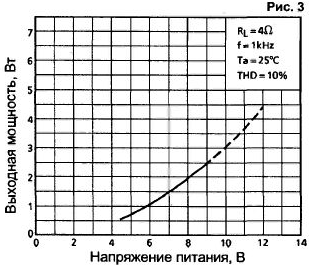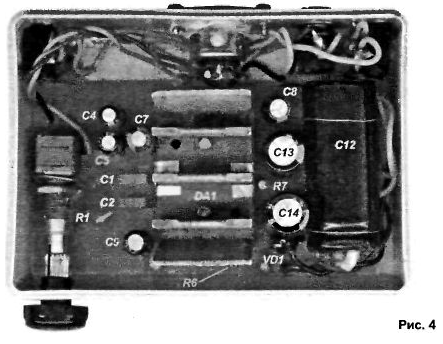
|
|
ENCYCLOPEDIA OF RADIO ELECTRONICS AND ELECTRICAL ENGINEERING Pocket stereo amplifier. Encyclopedia of radio electronics and electrical engineering
Encyclopedia of radio electronics and electrical engineering / Transistor power amplifiers The proposed simple stereo audio frequency amplifier is intended for use as a backup, for example, when repairing the main amplifier, as well as for better playback of phonograms from mobile devices, the built-in acoustics of which often leave much to be desired. The peculiarity of the amplifier is that it can be powered by almost any AC adapter or charger with a permissible load current of at least 350 mA. You can also use a 12 V voltage source from a computer power supply. The amplifier can work both on speaker systems and on headphones. The idea of creating such an amplifier was born after the request of a neighbor (an ardent fan of computer games) to improve her computer acoustics, but for the time of "torment" to give something in return. So it turned out to be a simple portable design that is easy to connect "to everything." The power amplifier circuit is shown in Fig. 1. UMZCH is assembled on an integrated circuit TA8217R. The choice fell on this microcircuit simply because I had it in stock and, in terms of its main parameters, was quite suitable for what was planned. The amplifier has a single control (volume), which is really hard to do without. If in rare cases you need to adjust the balance, then you will have to use the appropriate adjustment in the signal source, as well as the tone control. But, in my opinion, nowadays tone controls are an anachronism. The sound recording should initially be prepared so that it does not require any frequency response adjustments to listen to it, and the acoustics would normally reproduce all frequencies. Even 18 years ago, I noticed that the more you add "bottoms" and "tops *", the more you want to "raise" them: the ear adapts and cuts off everything superfluous. Stereo signals through volume controls R1.1 and R1.2, coupling capacitors C1, C2 and resistors R2. R3 are fed to the inputs of the DA1 chip. The voltage gain DA1 depends on the resistances R4 and R5. Capacitors C6 and C7 form a power filter for low-current components of the microcircuit, C8 and C9 - a voltage boost. Chains R7-C10, R6-C11 - damper, which prevent self-excitation of the amplifier at high frequencies. The output signals DA1 through capacitors C13, C14 are sent to dynamic heads or head stereo phones. The Schottky diode VD1 protects the amplifier from power reversal, and also allows you to power the amplifier with alternating voltage, for example, from a power supply for an external modem. Capacitors C12, C3 filter the supply voltage. The internal structure of the TA8217R chip is shown in Fig.2.
The harmonic coefficient of the amplifier is about 0,1% with a supply voltage of the microcircuit of 9 V and an output power of 0.5 W per channel. The resistance of the dynamic heads, on which the amplifier is loaded, is 3 ... 8 ohms. When connected to the amplifier output of headphones, both low-resistance (8 ... 16 Ohm) and high-resistance. the harmonic coefficient decreases. The dependence of the output power of the UMZCH on the supply voltage is shown in Fig. 3.
The amplifier is assembled on a circuit board, the thickness of which must be at least 1,5 mm. The board with the amplifier can be placed in a suitable plastic soap dish (Fig. 4). Several dozen holes with a diameter of 2,5 mm are drilled in the walls of the soap dish for better cooling.
Chip DA1 is installed immediately on two heat sinks. The first is glued with heat-conducting glue to the microcircuit case from above. This heatsink is screwed to the circuit board with two M3 screws. In order not to accidentally crush the microcircuit and avoid deformation, an aluminum plate is laid between its "bottom" and the board. The second heat sink made of sheet brass is soldered to the heat sink flanges of the microcircuit from the connection side. The area of this plate must be at least 6 cm2. The heat sink flanges of the microcircuit are connected directly to the "-" terminal of the capacitor C12. The negative power wire and the corresponding outputs of the speaker systems are connected to the same point. In other words, the signal circuits of the common wire should not intersect with the power ones [1]. Variable resistor - double small-sized (imported) with a resistance of 4,7 ... 100 kOhm. The body of this resistor is connected to a common wire. The remaining resistors are MLT.S1-4.S2-23. Oxide capacitors - imported analogues of K50-35, non-polar - ceramic K10-17.K10-50. I used part of the resistors and capacitors in the SMD version. Schottky diode can be replaced with 1N5819, SR360H. In extreme cases, on the usual - KD226A. KD212A. It is not possible to place all the necessary connectors for connecting various sound-reproducing equipment in the body of the soap dish, so if necessary, you can use the appropriate adapters. If there is no TA8217R chip, then a similar amplifier can be assembled on the domestic K174UN20 chip, which is also a two-channel amplifier with an output power of about 2.5 W per channel (Fig. 5).
This amplifier contains fewer parts, but in order for the description of the circuit in Fig. 1 to fit this amplifier, the part numbering is preserved. It should be noted that for the K174UN20 microcircuit, each heat-removing flange is counted as 2 pins. This microcircuit has a more thoughtful attachment to the heat sink, the same as that of the K174UN7, K174UNE microcircuits, so only one heat sink is enough. In my subjective opinion, the sound of the UMZCH on the K174UN20 chip at medium volume is better than that of the TA8217R. You may think otherwise, but. nevertheless, you should not strive to assemble the amplifier on the TA8217R. Literature
Author: A. Butov, village of Kurba, Yaroslavl region
Machine for thinning flowers in gardens
02.05.2024 Advanced Infrared Microscope
02.05.2024 Air trap for insects
01.05.2024
▪ Solar panel-sandwich for direct transmission of energy from space to terrestrial receivers ▪ Wireless HDMI Keychain for TVs ▪ Mobile workstation Eurocom Racer 3W ▪ Prosthetic hand sense of touch ▪ Wind power will fully provide Brazil with electricity
▪ section of the site for the radio amateur-designer. Article selection ▪ article It's too early for us to die - we still have things to do at home. Popular expression ▪ article What kind of work was done in Rus' by spitting? Detailed answer ▪ article Elecampane high. Legends, cultivation, methods of application ▪ article Bowls and confetti. Focus Secret
Home page | Library | Articles | Website map | Site Reviews www.diagram.com.ua |






 Arabic
Arabic Bengali
Bengali Chinese
Chinese English
English French
French German
German Hebrew
Hebrew Hindi
Hindi Italian
Italian Japanese
Japanese Korean
Korean Malay
Malay Polish
Polish Portuguese
Portuguese Spanish
Spanish Turkish
Turkish Ukrainian
Ukrainian Vietnamese
Vietnamese





 Leave your comment on this article:
Leave your comment on this article: